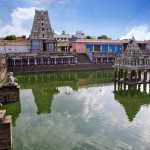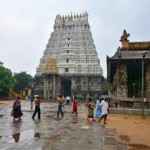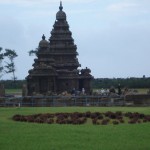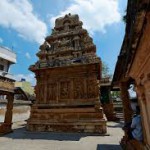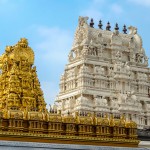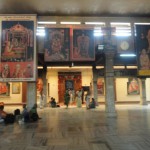| Kanchipuram Districts |
| About: |
| Kancheepuram District had been administered by the Pallavas, Cholas, Vijayanagar rulers, Muhammadan Kings, and the British before Independence. Tondaimandalam was an ancient division of Tamil country comprising roughly the present districts of Kancheepuram, Chennai, Tiruvallur, Vellore and Tiruvannamalai. The capital of Thondaimandalam was Kancheepuram.Kancheepuram District had been administered by the Pallavas, Cholas, Vijayanagar rulers and the British before Independence. It was a part of Tondaimandalam, a division of the ancient Tamil country, roughly comprising the present day districts of Kancheepuram, Chennai, Tiruvallur, Vellore and Thiruvannamalai. The capital of Thondaimandalam was Kancheepuram city. From the 3rd to the 9th century A.D. Kanchi was the capital of the Pallavas who ruled over the territory extending from the river Krishna in the north to the river Kaveri in the south. The Pallavas fortified the city with ramparts, moats, etc., with wide and well laid out roads and fine temples. They were a great maritime power with contacts with far-off China, Siam, Fiji, etc., through their chief Port Mamallapuram (Mahabalipuram). The Cholas ruled this region from the 10th century to the 13th century. Kings of Vijayanagar dynasty ruled from 14th century to 17th century.The Major breakthrough in the district administration was in 1788 when, for the first time, Collector was appointed to the district. The district was split up into two divisions, Northern and Southern and placed under two Collectors. The names of the Collectors during 1790’s were Clerk and Balfour.The British coined the name Conjeevaram, the anglicised version of Kancheepuram. Under the British regime, a Collector to the district was appointed for the first time in 1788 AD. The district was further split up into two divisions, Northern and Southern, and was placed under the administration of two Collectors. The Collectors during 1790’s were Clerk and Balfour. Lionel Place, the Collector in 1794-1799, created the posts of Sharistadars, who came under the control of the Collector. Clerks were also appointed to assist the Sharistadars. The famous Madurantakam and Uthiramerur tanks were created by Place. Hodgson, who was Head Assistant to Place, succeeded him as the Collector. The place he resided at Kancheepuram is still known in the name of Hodgsonpet. In 1800, Hodgson was succeeded by his Senior Assistant, Greenway.In the nineteenth century, Karunguzhi became the headquarters of the district and it remained so up to 1859 when it was shifted to ‘Home Garden’ Saidapettai, except for a short spell from 1825-1835 during which Kancheepuram served as the district headquarters. From 1859 to 1968, the Collector’s office was located in Saidapettai. |
| Kanchipuram is also one of the most industrialized districts in the country, thanks to its proximity to the state capital Chennai. Areas surrounding Sriperumbudur have turned out to become one of the largest manufacturing hubs of India. The district is home to the manufacturing units of Hyundai, Ford, Mitsubishi, Nokia, Samsung, Dell, Saint Gobain etc… The district is also at the center of the Information Technology boom in India. Many multinational IT companies like Tata Consultancy Services (TCS), Infosys, Wipro Technologies, Cognizant Technology Solutions etc.. |
| Location info: |
| Kancheepuram District,Tamil Nadu,India |
| Climate/Weather of Kanchipuram Districts: |
| Summer Max. 45.0 °C (113.0 °F) ,Min. 21.1 °C (70.0 °F) Winter Max28.7 °C (83.7 °F) ,Min.14.0 °C (57.2 °F) |
| History of Kanchipuram Districts: |
| The history of Kanchi can be traced back to several centuries before the advent of the Christian era. The place finds its name in Patanjali’s Mahabhashya, written in the second century B.C. Manimekalai, the famous Tamil classic, and Perumpanattu Padai, a great Tamil poetical work, vividly describe Kanchipuram city, as it was at the beginning of the Christian era. Pathupattu, one of the sangam literatures, reads that the king Thondaiman Ilandirayan ruled this town around 2500 years ago. |
| Educational Institutions of Kanchipuram Districts: |
| Arts & Science:Pachaiyappa’s College for Men, Kanchipuram, Kanchipuram Pachaiyappa’s College for Women, Kanchipuram, Kanchipuram Rajeswari Vedachalam Government Arts College, Kanchipuram Annai Theresa College of Arts and Science, Kanchipuram Apollo Arts and Science College, Kanchipuram C.S.I. Edward Women’s Christian College, Kanchipuram Kanchi Kamatchi Amman Arts and Science College for Women, Kanchipuram Taluk Kanchi Shri Krishna College of Arts and Science, Kanchipuram Meenakshi Ammal Arts and Science College for Women, Uthiramerur Pattammal Alagesan College of Arts and Science, Kanchipuram SCSVMV University (Sri Chandrasekharendra Saraswathi Viswa Mahavidyalaya), Kancheepuram Sri Muthukumaran Arts and Science College, Chennai Sri Sankara Arts and Science College, Kanchipuram Vidhya Sagar Women’s College, ChengalpattuAyurveda:Dharma Ayurveda Medical Research Institution, SriperumputhurHotel Management:S.R.M. Institute of Hotel Management, Kattankulatthur Apollo Arts and Science College, Kanchipuram C.S.I. Edward Women’s Christian College, KanchipuramDental:Karpaga Vinayaga Institute of Dental Sciences, Madhuranthagam Taluk Sri Venkateswara Dental College and Hospital, Chennai Adhiparasakthi Dental College and Hospital, Melmaruvathur Chettinad University (Chettinad Dental College and Research Institute), KelambakkamEngineering:Aksheyaa College of Engineering, Maduranthagam Asan Memorial College of Engineering and Technology, Chengalpattu Karpaga Vinayaga College of Engineering and Technology, Maduranthagam Taluk Maamallan Institute of Technology, Sriperumpudur Rajiv Gandhi College of Engineering, Sriperumbudur S.M.K. Fomra Institute of Technology, Chengelput Taluk Saveetha Engineering College, Sriperumbudur Taluk SRM University (S.R.M. Engineering College), Chengalpattu Taluk Valliammai Engineering College, Chengalpattu Taluk A.C.T. College of Engineering and Technology, Maduranthagam A.R.M. College of Engineering and Technology, Chengalpet Adhi College of Engineering and Technology, Kancheepuram Adhiparasakthi Engineering College, Cheyyar Taluk Apollo Engineering College, Sriperumbudur Arignar Anna Institute of Science and Technology, Sriperumpudur Taluk Balaji Institute of Engineering and Technology, Thiruporur Dhanalakshmi Srinivasan College of Engineering and Technology, Mamallapuram Indira Gandhi College of Engineering and Technology for Women, Chengalpattu Taluk JEI Mathaajee College of Engineering, Kancheepuram Kalsar College of Engineering, Sriperambudur Taluk Kanchi Pallavan Engineering College, Kancheepuram Kings Engineering College, Sriperumbudur Lord Venkateshwara Engineering College, Kanchipuram Taluk Loyola Institute of Technology, Sriperumbudur Taluk P.B. College of Engineering, Sriperumbudur P.T. Lee Chengalvaraya Naicker College of Engineering and Technology, Kancheepuram Pallavan College of Engineering, Kancheepuram Taluk Rajalakshmi Engineering College, Sriperumbudur Taluk Rajalakshmi Institute of Technology, Sriperumbudur Taluk Rrase College of Engineering, Sriperumbudur Sakthi Engineering College, Chennai Sakthi Mariamman Engineering College, Sriperumbudhur SCSVMV University (Sri Chandrasekharendra Saraswathi Viswa Mahavidyalaya), Kancheepuram Shri Andal Alagar College of Engineering, Madurantakam Taluk Sri Padmavathy College of Engineering, Valarpuram post Sri Venkateswara College of Engineering, Sriperumbudur St. Joseph College of Engineering, Sriperumpudur The New Royal College of Engineering and Technology, Thirukkalukundram Taluk Thirumalai Engineering College, Krishnapuram Post V.I. Institute of Technology, Chengalpet V.K.K. Vijayan Engineering College, Sriperumbudur |
| Langauge |
| Tamil Langauge |
| Culture: |
| Festivals: For a truly once in a lifetime experience, visit the Bannari Mariamman Temple and the Sri Aggnigunda Kali or Kodantha Kaliamman temple during the month of January when the famous fire walking ritual is held. |
| How to reach? |
| Nearest Railway Station:Chengalpattu is the nearest railhead. Delhi is conveniently connected through the Thirukkural Exp. (6:00, Sat) & T N Smprk Krnti (7:25, Tue, Thu) while Mumbai through the Madurai Exp. (00:15, Fri) & Nagarcoil Exp. (12:05, Tue, Sat). Daily trains running Chennai-Chengalpattu include the Nellai Exp. (21:00), Kanyakumari Exp. (17:30), Pandian Exp. (21:30), Pearl City Exp. (18:30), Anantapuri Exp. (19:30) & Rock Fort Exp. (22:30). |
| Nearest Airport:Chennai is the nearest and most convenient airport, connected by daily Indian Airlines flights from Delhi (6:40, 10:15, 16:45 & 19:00), Mumbai (7:05, 9:20, 11:45, 18:10 & 20:30), Bangalore(8:30) and Kolkata (14:30 & 18:10). |
| Road Transport:To travel by road from Chennai, take the national highway no. 45 to Chengalpattu and head south towards Padalam junction. A right turn here will lead to the sanctuary road. The sanctuary can also be accessed from other nearby towns of Kanchipuram and Mahabalipuram, but the road is not very well maintained. State transport buses ply between Chennai and Chengalpattu, the best option however would be to travel in your own four wheeler or hire a taxi from Chennai. |
| Tourist Attraction of Kanchipuram Districts: |
| Kamaski Temple: The Kanchi Kamaski Temple is one of the triad of temples. The triad includes Kanchi Kamakshi, Madurai Meenakshi and Kasi Visalakshi. This temple in Kanchipuram is an extremely famous one The Kanchi Kamaski Temple is one of the triad of temples. The triad includes Kanchi Kamakshi, Madurai Meenakshi and Kasi Visalakshi. This temple in Kanchipuram is an extremely famous one and is an excellent example of saktis. It is known for its absolutely exquisite sculptures. The sculptures are also painted vivid colors to make them almost come to life. One of the most famous sculptures in the temple is the larger than life sculpture of Kamakshi herself. The beauty of this one sculpture is worth the time and effort that it takes to visit this one templeEkambaranatha Temple: The Ekambaranatha Temple is the largest temple in Kanchipuram. It covers an impressive 20 acres. This particular temple has been dedicated to Lord Shiva, and was built by the Pallavas The Ekambaranatha Temple is the largest temple in Kanchipuram. It covers an impressive 20 acres. This particular temple has been dedicated to Lord Shiva, and was built by the Pallavas and then in turn was altered by both the Cholas and the Rayas. One remarkable feature of this temple is the fact that the 1000 lingas are all carved out of one solitary stone. Also, there are one thousand pillared halls found within the temple. Outside of the Ekambaranatha Temple there is a mango tree that is over 3500 years old. There are four separate limbs found on the tree that represent the Four Vedas (Rig, Yajur, Sama and Atharvana). Tradition has it that the fruit from each limb tastes different even though they all are on the same tree.Kamakshi Amman Temple: The Kamakshi Amman Temple is dedicated to the goddess Parvathi. It is believed to have been originally built by the Pallava kings before the 7th century, but was then later The Kamakshi Amman Temple is dedicated to the goddess Parvathi. It is believed to have been originally built by the Pallava kings before the 7th century, but was then later rebuilt by the Cholas during the 14th Century. This particular temple is located directly in the heart of Kanchipuram. It is known as one of the three holy places of Sakthi worship. At this temple there is a Sankaracharya shrine. Sankaracharya was the man who found the Kamakoti Monastery and is known as one of the greatest Hindu saints. He is also known for building a golden tower.Kachapeshwarar Temple: It is at the Kachapeshwarar Temple that the Lord Shiva can be seen being worshipped by Lord Vishnu in the form of Tortoise (Kachap). This image can be seen on .It is at the Kachapeshwarar Temple that the Lord Shiva can be seen being worshipped by Lord Vishnu in the form of Tortoise (Kachap). This image can be seen on sculptures and engravings that adorn this beautiful temple. It is unusual for a temple to be dedicated to one Hindu god, in this case Lord Shiva, and then show another god worshipping that entity. This occurrence is one of the items that make this particular temple unique. The beautiful interior of the temple is just as impressive as the exteriorKailasanathar Temple: The Kailasanathar Temple is one of the earliest and most remarkable temples that are found in the Kanchipuram area. It was built in the 7th century by the Pallava king . The Kailasanathar Temple is one of the earliest and most remarkable temples that are found in the Kanchipuram area. It was built in the 7th century by the Pallava king Rajasimha. This particular temple is an excellent example of early Dravidian architecture. One notable feature that is unique to this temple is that there is a 16-sided Shiva lingam that is made out of black granite at the main shrine. Both the elegant decorations that are carved on this temple as well as the architectural style of the building closely resemble the impressive sculptures that are found at Mahabalipuram.Vaikunda Perumal Temple: The Vaikunda Perumal Temple was built by the Pallava king Nadivarman II during the 7th century. This is particular temple is dedicated to Lord Vishnu. In fact, Lord Vishnu’s image .The Vaikunda Perumal Temple was built by the Pallava king Nadivarman II during the 7th century. This is particular temple is dedicated to Lord Vishnu. In fact, Lord Vishnu’s image can be seen in standing, sitting and reclining forms on towering vimanas that can be seen throughout the temple. There are also many beautiful lion pillared cloisters as well as several bas – reliefs in the main shrine of the temple. Inscriptions that tell of the history of the temple as well as the history of the city itself can be seen on the walls. India’s Department of Archeology cares for this temple.Kanchi Kudhil: The Hindu religion is prominent throughout all of India. Many of the temples that can be seen there are in fact Hindu temples. The ancient culture as well as the .The Hindu religion is prominent throughout all of India. Many of the temples that can be seen there are in fact Hindu temples. The ancient culture as well as the cultural heritage of Hinduism is shown at Kanchi Kudhil. This is a small house that shows exactly how the Hindu religion is intertwined into India’s history and modern day way of life. This fascinating place of discovery is open to visitors. There is no better way for a person of another faith to understand and appreciate the fascinating religion of Hinduism than to visit the Kanchi Kudhil.Devarajaswami Temple: The Devarajaswami Temple was built by the Vijaynagar kings. It is dedicated to the Hindu god Lord Vishnu. There are elaborately carved pillars that can be seen throughout the temple.The Devarajaswami Temple was built by the Vijaynagar kings. It is dedicated to the Hindu god Lord Vishnu. There are elaborately carved pillars that can be seen throughout the temple. This particular temple has a marriage hall that was built in remembrance of the marriage between Lord Vishnu and Goddess Laxmi. There is a water tank that contains a large statue of Lord Vishnu inside the water. The tank is drained every 40 years. At that time, the 10 meter high statue can be seen, and is then established for darshan for 48 days before it is immersed in water once again. There is also an enormous chain that was engraved out of one single stone.Varadaraja Temple: The beautiful Varadaraja Temple was built during the 10th century by the Vijayanagar kings. There is a big outer wall that surrounds this fine temple. It also has an impressiveVedanthangal: Birds at Vadanthangal bird sanctuaryIt is one of the major Water Bird Sanctuaries in India, 48 km from Kanchipuram. Storks, Egrets, Cormorants, Darter, Flamingos, Pelicans, moor hens, herons, kingfishers, sandpipers, white ibis, spoonbills, swans and grey wagtails are some of the birds which arrive here during season. The best time to visit is between October and March, when a large number of migratory birds visit. The birds can be viewed from the bank or from the watch tower.Muttukadu: This is a large lake formed out of the backwaters from Bay of Bengal. It has boating and wind surfing facilities. It is located at a distance of 80 km from Kanchipuram . The backwaters of Muttukkadu have been developed by the Tamil Nadu Tourism Development Corporation to serve as a picnic spot and a center for water sports. Training and demonstration programmes are also organised for beginners.Mamallapuram: It was a flourishing port town during the time of Pallavas. This is one of the main tourist places in kanchipuram. The monuments of Mamallapuram are excellent specimen of Dravidian temple architecture and Pallava art. The group of sculptures in Mamallapuram are listed out by UNESCO as World Heritage Sites.Covelong: This is a small fishing village 40 km from Chennai on the Mahabalipuram road. There are the remains of a fort, which now functions as a luxury beach resort. Facilities for windsurfing and swimming are available here. A dargah and an ancient church are also located here. Crocodiles in Crocodile BankDakshina Chitra: Dakshina Chitra has relocated 18th, 19th and early 20th century houses and re-created village streets and work places providing authentic insights into the domestic architecture, spatial organisation, life-styles and character of the essential Tamil or Keralite or Andhrite or Kannadiga. The Crocodile Bank: Just 14 km from Mamallapuram is this crocodile breeding center. At this center, about 5000 crocodiles of 6 different species, alligators & other reptiles are bred in captivity, kept in open, marshy enclosures. There is also a snake farm where anti venom is produced and there is a regular venom extraction show. |
| Hotels/Lodge/Accommodation in Kanchipuram Districts: |
| MM Hotel:65, 66 Nellukara Street,, Kanchipuram, Tamil Nadu,Ph: 044 27227250Hotel Saravana Bhavan:Kanchipuram, Tamil Nadu |
| Links: |
| http://kanchi.tn.nic.in/ |
